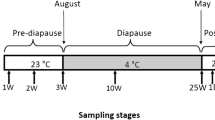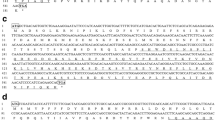Abstract
We identify and characterize 14 small heat-shock protein (sHSP) genes from the diamondback moth (DBM), Plutella xylostella (L.), a destructive pest. Phylogenetic analyses indicate that, except for sHSP18.8 and sHSP19.22, the other 12 DBM sHSPs belong to five known insect sHSP groups. Developmental expression analysis revealed that most sHSPs peaked in the pupal and adult stages. The transcripts of sHSPs display tissue specificity with two exhibiting constitutive expression in four tested tissues. Expression of sHSP18.8 in fourth instar larvae is not induced by the tested abiotic stressors, and unless sHSP21.8 is not sensitive to thermal stress, 12 sHSPs are significantly up-regulated. The messenger RNA (mRNA) levels of all sHSPs are reduced under oxidative stress. Food deprivation leads to significant down-regulation of three sHSPs. The majority of sHSPs show expression variation to various heavy metals, whereas mRNA abundances of sHSP22.1 and sHSP 28.9 are reduced by four heavy metals. The responses of sHSPs to indoxacarb and cantharidin are varied. Beta-cypermethrin and chlorfenapyr exposure results in an increase of 13 sHSP transcripts and a reduction of 12 sHSP transcripts, respectively. These results show that different sHSPs might play distinct roles in the development and regulation of physiological activities, as well as in response to various abiotic stresses of DBM.








Similar content being viewed by others
References
Aevermann BD, Waters ER (2008) A comparative genomic analysis of the small heat shock proteins in Caenorhabditis elegans and briggsae. Genetica 133:307–319
Basha E, Friedrich KL, Vierling E (2006) The N-terminal arm of small heat shock proteins is important for both chaperone activity and substrate specificity. J Biol Chem 281:39943–39952
Basha E, O’Neill H, Vierling E (2012) Small heat shock proteins and α-crystallins: dynamic proteins with flexible functions. Trends Biochem Sci 37:106–117
Basha E, Jones C, Blackwell AE, Cheng G, Waters ER, Samsel KA, Siddique M, Pett V, Wysocki V, Vierling E (2013) An unusual dimeric small heat shock protein provides insight into the mechanism of this class of chaperones. J Mol Biol 425:1683–1696
Colinet H, Lee SF, Hoffmann A (2010) Temporal expression of heat shock genes during cold stress and recovery from chill coma in adult Drosophila melanogaster. FEBS J 277:174–185
Concha C, Edman RM, Belikoff EJ, Schiemann AH, Carey B, Scott MJ (2012) Organization and expression of the Australian sheep blowfly (Lucilia cuprina) hsp23, hsp24, hsp70 and hsp83 genes. Insect Mol Biol 21:169–180
Franck E, Madsen O, van Rheede T, Ricard G, Huynen MA, de Jong WW (2004) Evolutionary diversity of vertebrate small heat shock proteins. J Mol Evol 59:792–805
Garczynski SF, Unruh TR, Guédot C, Neven LG (2011) Characterization of three transcripts encoding small heat shock proteins expressed in the codling moth, Cydia pomonella (Lepidoptera: Tortricidae). Insect Sci 18:473–483
Gehring WJ, Wehner R (1995) Heat shock protein synthesis and thermotolerance in Cataglyphis, an ant from the Sahara desert. Proc Natl Acad Sci U S A 92:2994–2998
Gkouvitsas T, Kontogiannatos D, Kourti A (2008) Differential expression of two small Hsps during diapause in the corn stalk borer Sesamia nonagrioides (Lef.). J Insect Physiol 54:1503–1510
Gu J, Huang LX, Shen Y, Huang LH, Feng QL (2012) Hsp70 and small Hsps are the major heat shock protein members involved in midgut metamorphosis in the common cutworm, Spodoptera litura. Insect Mol Biol 5:535–543
Haslbeck M (2002) sHsps and their role in the chaperone network. Cell Mol Life Sci 59:1649–1657
Haslbeck M, Franzmann T, Weinfurtner D, Buchner J (2005) Some like it hot: the structure and function of small heat-shock proteins. Nat Struct Mol Biol 12:842–846
Hayward SAL, Pavlides SC, Tammariello SP, Rinehart JP, Denlinger DL (2005) Temporal expression patterns of diapause-associated genes in flesh fly pupae from the onset of diapause through post-diapause quiescence. J Insect Physiol 51:631–640
Huang LH, Kang L (2007) Cloning and interspecific altered expression of heat shock protein genes in two leafminer species in response to thermal stress. Insect Mol Biol 16:491–500
Huang LH, Wang CZ, Kang L (2009) Cloning and expression of five heat shock protein genes in relation to cold hardening and development in the leafminer, Liriomyza sativa. J Insect Physiol 55:279–285
Jouraku A, Yamamoto K, Kuwazaki S, Urio M, Suetsugu Y, Narukawa J, Miyamoto K, Kurita K, Kanamori H, Katayose Y, Matsumoto T, Noda H (2013) KONAGAbase: a genomic and transcriptomic database for the diamondback moth, Plutella xylostella. BMC Genomics 14:464
Kappé G, Franck E, Verschuure P, Boelens WC, Leunissen JA, de Jong WW (2003) The human genome encodes 10 α-crystalline-related small heat shock proteins: HspB1-10. Cell Stress Chaperones 8:53–61
Kokolakis G, Kritsidima M, Tkachenko T, Mintzas AC (2009) Two hsp23 genes in the Mediterranean fruit fly, Ceratitis capitata: structural characterization, heat shock regulation and developmental expression. Insect Mol Biol 18:171–181
Kriehuber T, Rattei T, Weinmaier T, Bepperling A, Haslbeck M, Buchner J (2010) Independent evolution of the core domain and its flanking sequences in small heat shock proteins. FASEB J 24:3633–3642
Li ZW, Li X, Yu QY, Xiang ZH, Kishino H, Zhang Z (2009) The small heat shock protein (sHSP) genes in the silkworm, Bombyx mori, and comparative analysis with other insect sHSP genes. BMC Evol Biol 9:215
Liu Z, Xi D, Kang M, Guo X, Xu B (2012) Molecular cloning and characterization of Hsp27. 6: the first reported small heat shock protein from Apis cerana cerana. Cell Stress Chaperones 17:539–551
Livak KJ, Schmittgen TD (2001) Analysis of relative gene expression data using real-time quantitative PCR and the 2(−Delta Delta C(T)) method. Methods 25:402–408
Lu MX, Hua J, Cui YD, Du YZ (2014) Five small heat shock protein genes from Chilo suppressalis: characteristics of gene, genomic organization, structural analysis, and transcription profiles. Cell Stress Chaperones 19:91–104
Martínez-Paz P, Morales M, Martín R, Martínez-Guitarte JL, Morcillo G (2013) Characterization of the small heat shock protein Hsp27 gene in Chironomus riparius (Diptera) and its expression profile in response to temperature changes and xenobiotic exposures. Cell Stress Chaperones. doi:10.1007/s12192-013-0479-y
Nguyen TTA, Michaud D, Cloutier C (2009) A proteomic analysis of the aphid Macrosiphum euphorbiae under heat and radiation stress. Insect Biochem Mol Biol 39:20–30
Poulain P, Gelly JC, Flatters D (2010) Detection and architecture of small heat shock protein monomers. PLoS One 5:e9990
Quinlan R (2002) Cytoskeletal competence requires protein chaperones. Prog Mol Subcell Biol 28:219–234
Rinehart JP, Li A, Yocum GD, Robich RM, Hayward SA, Denlinger DL (2007) Up-regulation of heat shock proteins is essential for cold survival during insect diapause. Proc Natl Acad Sci U S A 104:11130–11137
Sakano D, Li B, Xia Q, Yamamoto K, Fujii H, Aso Y (2006) Genes encoding small heat shock proteins of the silkworm, Bombyx mori. Biosci Biotechnol Biochem 70:2443
Sang W, Ma WH, Qiu L, Zhu ZH, Lei CL (2012) The involvement of heat shock protein and cytochrome P450 genes in response to UV-A exposure in the beetle Tribolium castaneum. J Insect Physiol 58:830–836
Saravanakumar R, Ponnuvel KM, Qadri SMH (2008) Expression of metabolic enzyme genes and heat-shock protein genes during embryonic development in diapause and non-diapause egg of multivoltine silkworm Bombyx mori. Biologia 63:737–744
Shen Y, Gu J, Huang LH, Zheng SC, Liu L, Xu WH, Feng QL, Kang L (2011) Cloning and expression analysis of six small heat shock protein genes in the common cutworm, Spodoptera litura. J Insect Physiol 57:908–914
Sonoda S, Tsumuki H (2007) Induction of heat shock protein genes by chlorfenapyr in cultured cells of the cabbage armyworm, Mamestra brassicae. Pestic Biochem Physiol 89:185–189
Sonoda S, Ashfaq M, Tsumuki H (2007) A comparison of heat shock protein genes from cultured cells of the cabbage armyworm, Mamestra brassicae, in response to heavy metals. Arch Insect Biochem 65:210–222
Sun Y, MacRae TH (2005) Small heat shock proteins: molecular structure and chaperone function. Cell Mol Life Sci 62:2460–2476
Takahashi KH, Rako L, Takano-Shimizu T, Hoffmann AA, Lee SF (2010) Effects of small Hsp genes on developmental stability and microenvironmental canalization. BMC Evol Biol 10:284
Trisyono A, Whalon ME (1997) Fitness costs of resistance to Bacillus thuringiensis in Colorado potato beetle (Coleoptera: Chrysomelidae). J Econ Entomol 90:267–271
Tsvetkova NM, Horvath I, Torok Z, Wolkers WF, Balogi Z, Shigapova N, Crowe LM, Tablin F, Vierling E, Crowe JH, Vigh L (2002) Small heat shock proteins regulate membrane lipid polymorphism. Proc Natl Acad Sci U S A 99:13504–13509
van Montfort RL, Basha E, Friedrich KL, Slingsby C, Vierling E (2001) Crystal structure and assembly of a eukaryotic small heat shock protein. Nat Struct Mol Biol 8:1025–1030
van Montfort R, Slingsby C, Vierling E (2002) Structure and function of the small heat shock protein/alpha-crystallin family of molecular chaperones. Adv Protein Chem 59:105–156
Wang H, Li K, Zhu JY, Fang Q, Ye GY (2012) Cloning and expression pattern of heat shock protein genes from the endoparasitoid wasp, Pteromalus puparum in response to environmental stresses. Arch Insect Biochem 79:247–263
Waters ER, Rioflorido I (2007) Evolutionary analysis of the small heat shock proteins in five complete algal genomes. J Mol Evol 65:162–174
Waters ER, Aevermann BD, Sanders-Reed Z (2008) Comparative analysis of the small heat shock proteins in three angiosperm genomes identifies new subfamilies and reveals diverse evolutionary patterns. Cell Stress Chaperones 13:127–142
Zhao L, Jones WA (2012) Expression of heat shock protein genes in insect stress responses. Invertebr Surviv J 9:93–101
Acknowledgments
We sincerely thank Prof. John Richard Schrock (Emporia State University, USA) for revising the manuscript. This research is supported by the Special Fund for the Public Interest (Agriculture) (200903052) by The Ministry of Science and Technology and The Ministry of Agriculture of China and the ‘13115’ Sci-Tech Innovation Project of Shaanxi Province (2007ZDKG-14).
Author information
Authors and Affiliations
Corresponding author
Rights and permissions
About this article
Cite this article
Chen, X., Zhang, Y. Identification of multiple small heat-shock protein genes in Plutella xylostella (L.) and their expression profiles in response to abiotic stresses. Cell Stress and Chaperones 20, 23–35 (2015). https://doi.org/10.1007/s12192-014-0522-7
Received:
Revised:
Accepted:
Published:
Issue Date:
DOI: https://doi.org/10.1007/s12192-014-0522-7




